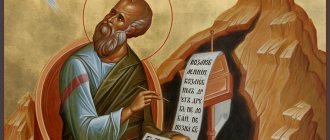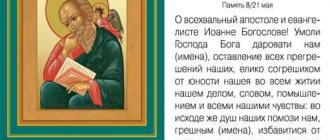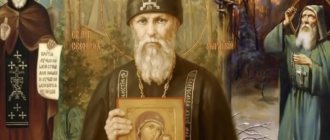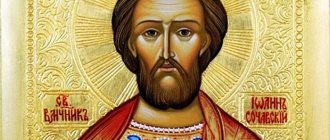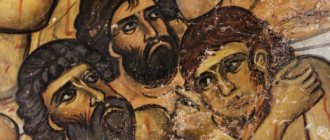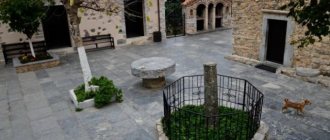John Zebedee and his younger brother James were disciples of Christ. They were called by Jesus as young men on Lake Gennesaret, where they had left their father's house. According to legend, the parents of John and Jacob were called Zebedee and Salome, and the family lived by fishing. Together with the Apostle Peter, the brothers were the disciples closest to Jesus; it was they who were present in the Garden of Tabor during the Transfiguration of the Lord. There are icons in which John the Theologian is depicted as young and beardless, with long hair. According to legend, Jesus called the brothers “sons of thunder” for their ardent love for the Christian faith.
Memorial Days:
- May 21st
- July 13 – Council of the glorious and all-praised 12 apostles
- October 9 – Repose
Life of the Apostle John
The face of the Apostle John the Theologian can be found very often on icons. He not only saw Christ during his lifetime and was his disciple, but was also present at the arrest of Jesus and observed his torture and execution. Together with the Mother of God, he mourned the Lord at the foot of the Cross, and then did not leave the Mother of God until her Dormition. Only after this, John, together with his disciple Prochorus, left Jerusalem and headed to Ephesus, to carry God’s will and convert to the Christian faith. On the way to Ephesus, the ship carrying John and his disciple crashed, everyone survived, but the saint disappeared. Two weeks later, Prokhor found his teacher alive on the shore; God did not abandon his faithful student.
There were many miracles in the life of the Apostle John. The twelve apostles were not spared the persecution of Christians at the beginning of our era. It is known that John was sentenced, his death awaited him in a cup of poison. But having drunk from the vessel at the appointed time, John remained alive. Then it was decided to execute him by dousing him with boiling oil, but this did not cause any harm. After suffering, he was exiled to the island of Patmos in captivity. John lived on this island for a very long time, continuing to carry faith in the Lord, thereby incurring the wrath of the local pagans. Over the years spent on the island, the saint healed the sick many times and even resurrected the recently deceased.
The most common name of the apostle is John the Theologian. He received it for his labors: the fourth Gospel was written by the hand of John, and he also wrote the Revelation of John the Theologian. A separate story covers the period of writing these books. They were written on a mountain on the island of Patmos in a small cave where John went to pray. One day, after the third day of prayers, without food and only with his disciple. During the prayer, thunder erupted and the mountain shook, and then John heard the voice of God. Then he ordered his student to write down every word; it is believed that through John the voice of the Most High dictated to Prokhor. This is how the Revelation of John the Theologian was written, which is called the Apocalypse.
John lived longer than all the rest of the twelve apostles; he was the only one who died a natural death, and not from torture. At the time of his death, John the Theologian was about a hundred years old, which is a great achievement for our time. The apostle died in Ephesus, where he was allowed to return after a long imprisonment. Every year on May 21, the feast day of St. John the Evangelist is celebrated, and a thin layer of miraculous, healing ashes appears on his grave.
Childhood and youth
Church literature claims that the family of the Apostle John traces its origin back to King David. The betrothed husband of the Blessed Virgin Mary, Joseph the Carpenter, had a daughter, Salome, who married Zebedee. Salome and Zebedee had two sons: James and John.
Young Apostle John
Evangelist Mark mentions in the writings that John, his older brother James and his father were fishing from a boat when the call of Christ sounded. The brothers left their catch and their father and followed the Lord. Luke in the writings adds that the newly minted apostles were present at the miraculous fishing and, impressed, turned to the Savior. The young men did not doubt their choice for a moment: they left everything they had and followed the Teacher.
For his impulsive character, keen sense of justice and masterful use of words, Christ nicknamed John the Theologian “Son of Thunder.” These features clearly manifested themselves during the ninth and last walk of the Lord through Galilee: Jesus wanted to go to Jerusalem, but before that he sent messengers to the Samaritan village.
Apostle brothers James and John
However, the residents of the settlement did not accept the Savior. Then John and his brother Jacob asked Christ if they could call fire from heaven to punish the inhabitants of the Samaritan village, but the Lord stopped the excited apostles, because Jesus brings salvation to people, not punishment.
The Apostle John, together with his brother James, were especially close to Peter and were considered closest to the Lord.
The image of John the Evangelist in iconography
Many icons are painted with the face of the saint; their subjects cover his entire life. The most common icon is of John the Theologian with a book - the Gospel. He is depicted with a pen and inkwell, working on writing a sacred legend. The Apostle John has his own sign - an eagle, which can often be found in images of the saint. The image of a saint with a book is sometimes complemented by an angel above the apostle’s shoulder, which shows us the Divine will guiding John.
One of the most famous icons of the saint is the icon of John the Theologian in silence. This type of iconography originates in the middle of the 16th century. On the icon, together with the saint, an angel and an eagle with an inkwell are depicted; together they show the entire path of the apostle. John always holds two fingers to his lips as a sign of silence.
Temples and monasteries in the name of John the Theologian in Rus'
In the name of the Apostle and Evangelist John the Theologian, the church on Varyazhki in Smolensk . The church was built in the 1160s and is a cross-domed single-domed building. The facade of the church is divided into three parts, each of which has windows. There is a portal on the eastern side of the facade. The building is crowned with a helmet-shaped head with a massive octagonal drum. At the top there is a small bulbous head. In the post-revolutionary years, the temple was closed and looted. Heavily damaged during the battles for the city in 1941-1943: the bell tower, refectory and chapel were completely destroyed. The temple was transferred to the local diocese of the Russian Orthodox Church in 1993. In 1994-1995, restoration work was carried out in the interior of the temple, and an iconostasis was installed.
Church of St. John the Evangelist on Varyazhki. Smolensk
In the name of the Apostle and Evangelist John the Theologian, the church from Misharina Mountain in Pskov . The church dates from 1547. The temple is placed on a basement with four pillars and three semicircular apses. In the decoration of the facades with lobed arches and apses with roller patterns, curbs and runners, a new detail appears: a cross without a roller, laid out around the window of the central apse. The church is active.
Church in the name of the Apostle and Evangelist John the Theologian on Misharina Mountain. Pskov
In the name of the holy apostle and evangelist John the Theologian, the Cathedral of the St. John the Theologian Savvo-Krypetsky Monastery in the village of Kripetskoye-1, Pskov region, . The cathedral church in the name of the Apostle John the Theologian was consecrated in 1557. The cathedral is stone, four-pillared, single-domed, on a high basement. At the beginning of the 20th century, the cathedral was reconstructed. In 1922, all valuables were removed from the monastery and the cathedral. Divine services in the cathedral ceased in 1923. In the 1950s in the basement of the temple there was a barnyard and a stable. In 1995, the Krypetsky Monastery became active again.
Krypetsky St. John the Theologian Monastery in the Pskov region
In the name of the holy apostle and evangelist John the Theologian, the Cherdyn St. John the Theologian Monastery in the city of Cherdyn, Perm Territory, was consecrated . St. John the Theologian Monastery was founded by Saint Jonah, Bishop of Perm, in 1462-1463. In 1718, a new stone two-altar church was built in the monastery. In 1764, Catherine II carried out a church reform, as a result of which many monasteries and churches were closed; the St. John the Theologian Monastery was left to its own maintenance, as a result of which it fell into complete decline and was closed in 1784. With the beginning of the revolutionary unrest in 1917, the monastery was persecuted by atheists. In 2004, the Cherdynsky Monastery was reopened as a men's monastery.
Church of St. John the Theologian of the Cherdyn St. John the Theologian Monastery
In 1478, the Cheremenets St. John the Theologian Monastery was founded, located on a peninsula on Lake Cheremenets in the Luga district of the Leningrad region in the town of Cheremenets, Skreblovsky rural settlement . The first mention of the monastery dates back to 1498. According to legend, during the reign of John III (1440-1505) in 1478, on the island where the monastery is located, an icon of the holy apostle and evangelist John the Theologian appeared to the peasant Mokiy. The prince, having learned about this phenomenon, ordered to found a monastery on the island in the name of the apostle.
Cheremenetsky St. John the Theologian Monastery. Early 20th century photography
In the name of the holy apostle and evangelist John the Theologian, the oldest wooden church in the city of Pereyaslavl-Khmelnitsky, Ukraine, . The construction dates back to 1606. It is a three-domed building with chapters arranged in one row. The logs of the vestibule and nave are rectangular in shape, the altar is faceted, built on five sides of an octagon. The church was transported from the village of Ostroiki and is located on the territory of the Museum of Folk Architecture and Life. In Soviet times, it housed a museum of atheism, and now it is a museum of the UOC.
Church of St. John the Evangelist in Pereyaslavl-Khmelnitsky, Ukraine
In the name of the holy apostle and evangelist John the Theologian, the chapel of the cathedral in honor of the Epiphany of the Lord of the Avraamiev Epiphany Monastery in Rostov the Great, Yaroslavl region . The monastery was founded in 1261. The cathedral was built between 1553 and 1554. and is a three-aisle, five-domed, cross-domed, four-pillar, three-apse temple. During the Time of Troubles, the Avraamiev Monastery was plundered by the Poles. In the middle of the 17th century, under Archimandrite Jonah, the stone Vvedenskaya and Gate St. Nicholas churches were erected. In the XX-XXI centuries. The Avraamiev Monastery has undergone poor quality restoration. Currently, the condition of the monastery is unsatisfactory.
Avraamiev Monastery in Rostov the Great
In the name of the holy apostle and evangelist John the Theologian, the chapel of the cathedral in honor of the Annunciation of the Most Holy Theotokos of the Murom Annunciation Monastery in the city of Murom, Vladimir Region . The first wooden church in the name of the Annunciation of the Blessed Virgin Mary was erected in Murom in 1192. In 1553, construction of the Annunciation Monastery began on the site of the church. In 1612-1616, the monastery was badly damaged by fires, in addition, it was plundered by the Poles, but the monastery’s prosperity was soon restored, and the Annunciation Church, according to the inventory of 1637, “after being devastated by the Poles, was renewed by the abbot.” The high cube of the main volume of the temple is covered with a closed vault, which is decorated with two rows of kokoshniks. The third row is visually formed by kokoshniks at the base of the drums of each of the five chapters. The main element of modest decor is window trim. The drums of the five domes of the cathedral are very carefully decorated.
Cathedral in honor of the Annunciation of the Blessed Virgin Mary of the Murom Annunciation Monastery
In the name of the holy apostle and evangelist John the Theologian, the chapel of the Church of St. Basil the Great on Gorka in Pskov . The stone building of the Church of Vasily on Gorka was built in 1413 on the site of a wooden building built in 1377. During the Soviet years the church was closed. The building was heavily damaged during the Second World War. From 1945 to 1998, the State Archive (document repository) of the Pskov region was located in the church building. Reconstruction began in 1998, but the church building was severely damaged during a fire in 2003. The temple building was transferred to the Russian Orthodox Church community in 2003.
Church of St. Basil the Great on Gorka in Pskov
In the name of the holy Apostle and Evangelist John the Theologian, the chapel of the Church of St. Nicholas of Usokha in Pskov . The church was first built in 1371, and in 1536, after a fire, it was rebuilt. A large, single-domed, three-apse stone church with a northern pillarless aisle in the name of the Presentation of the Lord; on the south side there may have been a warm chapel in the name of John the Evangelist; both aisles had porches. The vestibules - the main one, western, and the side ones - northern and southern - were connected by a gallery. However, alterations of the 17th–19th centuries. significantly distorted the appearance of the temple.
Church of St. Nicholas of Usokha in Pskov
In the name of the holy Apostle and Evangelist John the Theologian, churches in Georgia were consecrated (approximately 1577), in the village. Margarites of Greece (between 1450 and 1500) and in Ohrid Macedonia (between 1270 and 1280).
How does the icon of John the Evangelist help?
They turn to the icon of St. John the Theologian in search of family happiness; it helps to stop all quarrels and conflicts.
Women at the icon of John the Evangelist ask for maternal happiness
Prayer before the icon of John will help fishermen and all others who are seeking salvation from accidents on the water. Prayer to the icon of the Apostle John will also help with health problems. Of course, the meaning of the icon is that people turn to the saint in search of help in journalism and writing. The apostle will protect from evil spirits and ward off bad thoughts.
Biography
The Apostle John, later called John the Theologian, was known as a particularly beloved disciple of Christ. Jesus emphasized the sacrifice and spiritual purity of John, and therefore John became one of the apostles especially close to Christ.
Apostle John
The Lord Himself nicknamed John “Son of Thunder.” Hearing the call of the savior, the boy left his home and rushed after the Preacher. It was John who fell to the chest of Jesus at the last meal of Christ, and later in the texts of the books he proved that the Lord personifies love.
Prayers before the icon
Troparion, tone 2
Apostle, beloved of Christ God, / hasten to deliver the irresponsible people, / he receives you, falling, / who fell on Persia and was received. / Pray to him, O Theologian, / and the surrounding cloud of tongues disperse the crowds, // asking us for peace and great mercy.
Translation: Apostle, beloved by Christ God, hasten to deliver defenseless people! The One who accepted you when you fell to His chest accepts your prayer. Pray to Him, O Theologian, to dispel the approaching cloud of paganism, asking for peace and great mercy for us.
Troparion, voice 2
Apostle, beloved of Christ God, / hasten to deliver the irresponsible people, / he receives you, falling, / who fell on the Persian received. / Pray to him, O Theologian, / and disperse the present darkness of tongues ati, // asking us for peace and great mercy.
Translation: Apostle, beloved by Christ God, hasten to deliver defenseless people! The One who accepted you when you fell to His chest accepts your prayer. Pray to Him, O Theologian, to dispel the approaching darkness of paganism, asking for peace and great mercy for us.
Kontakion, tone 2
Your greatness, virgin, who is the storyteller?/ Perform miracles, and pour out healings,/ and pray for our souls,// as the Theologian and friend of Christ.
Translation: Who can tell about your greatness, virgin? For you pour out miracles and pour out healings, and intercede for our souls, as the Theologian and friend of Christ.
Greatness
We magnify you, Apostle of Christ and Evangelist John the Theologian, and honor your illnesses and labors, in which you worked in the gospel of Christ.
First prayer
Oh, great apostle, loud-voiced evangelist, most graceful theologian, seer of the secrets of ineffable revelations, virgin and beloved confidante of Christ John! Accept us, sinners, who come running under your strong intercession and protection. Ask the All-Generous Lover of Mankind, Christ our God, Who poured out His blood for us, His needless servants, before you combed, so that He may not remember our iniquities, but may He have mercy on us and do with us according to us His kindness: may He grant us health of soul and body, all prosperity and abundance, instructing us to turn it into the glory of Him, the Creator, Savior and our God, after the end of our temporary life from the merciless torturers in aerial ordeals and huts He guides us, and so may we reach, through you, the waters and the covering of the mountainous city of Jerusalem, You have seen its glory in revelation, and now you enjoy endless joys. O great John! Save all Christian cities and countries and all who call on your name from famine, destruction, cowardice and flood, fire and sword, invasion of foreigners and internecine warfare; Deliver us from all misfortune and adversity, and with your prayers turn away the righteous wrath of God from us, and ask us for His mercy. O great and incomprehensible God! Behold, for Your supplication we offer Saint John, to whom You have vouchsafed unspeakable revelations, accept intercession for us, grant us the fulfillment of our petitions for Your glory, and moreover make us spiritually perfect the chance to enjoy, endless life in Your Heavenly abodes! O Heavenly Father, Creator of all things, Omnipotent King! Touch our hearts with grace, so that, melting like wax, they will be poured out before You and mortal spiritual creation will be created in honor and glory of Yours, and Your Son, and the Holy Spirit. Amen.
Second prayer
Oh, great and all-praised apostle and evangelist John the Theologian, confidante of Christ, our warm intercessor and quick helper in troubles! Pray to the Lord God to grant us forgiveness of all our sins, even if we have sinned from our youth throughout our lives, in our deeds, words, thoughts and all our feelings; at the exodus of our souls, help us, sinners (names), to get rid of airy ordeals and eternal torment, and with your merciful intercession we glorify the Father and the Son and the Holy Spirit, now and ever and ever eki centuries. Amen.
( 4 ratings, average: 5.00 out of 5)
Troparion, voice 2*
Audio:
0:31
Apostle, beloved of Christ God, / hasten to deliver the irresponsible people, / he receives you, falling, / who fell on Persia and was received. / Pray to him, O Theologian, / and the surrounding cloud of tongues disperse the crowds, // asking us for peace and great mercy.
Translation: Apostle, beloved by Christ God, hasten to deliver defenseless people! The One who accepted you when you fell to His chest accepts your prayer. Pray to Him, O Theologian, to dispel the approaching cloud of paganism, asking for peace and great mercy for us.
John of Kronstadt:
Days of Remembrance (according to the present day): 2.01, 14.06.
Known in the world as John Ilyich Sergiev, this prophet was born in 1829. in the village of Sura (Arkhangelsk province). Throughout his life he carried the covenants given to him at the beginning of his journey. He was educated at the parish school of Arkhangelsk, and then at the St. Petersburg Theological Academy. He received the name John of Kronstadt when he secured the position of deacon in St. Andrew's Cathedral in Kronstadt.
He sincerely believed that the local laborers exiled here for misconduct were not hopeless drunkards and tramps. John loved each of them with all his heart, steadfastly endured ridicule and bullying, and helped in everything he could help with. He went from house to house, leaving his soul, love, care in each, and distributed money and things to those in need.
Later, his miraculous gift was revealed: he prayed for health, for a miracle, and God heard these passionate, sincere words. His kindness and self-sacrifice paid off handsomely: words of gratitude and donations began to flock to John from all over the country. With this money, John of Kronstadt built a temple, a convent and a “house of industriousness.” He gained unprecedented popularity after taking part in the coronation of Nicholas II.
They pray to Saint John of Kronstadt for deliverance from drunkenness, for healing and for a miracle.
John the Baptist (Forerunner):
Days of remembrance (according to the current calendar): 20.01, 9.03, 7.06, 7.07, 11.09, 6.10, 25.10.
John the Baptist is the last righteous man of the Old Testament and the harbinger (of the Forerunners) of the era of the New Testament. His life story is found in the chapter of the Gospel of Luke. John was a long-awaited child, his appearance was a real miracle. He led an ascetic life away from people, and by the age of thirty he began to preach the imminent establishment of the Kingdom of God.
Thanks to short, sincere sermons, many people of other faiths converted to Christianity in order to find repentance. He performed the rite of purification over everyone with the water of the Jordan River, for which he was called the Baptist. One day Jesus came to a sermon, was baptized and was named Savior.
John the Baptist openly accused Herod Antipas of violating the rules and customs of the time, for which the ruler put him in prison and later cut off his head.
Carved icons depicting John the Baptist are prayed for success in work, so that any undertaking will bear blessed fruits.
